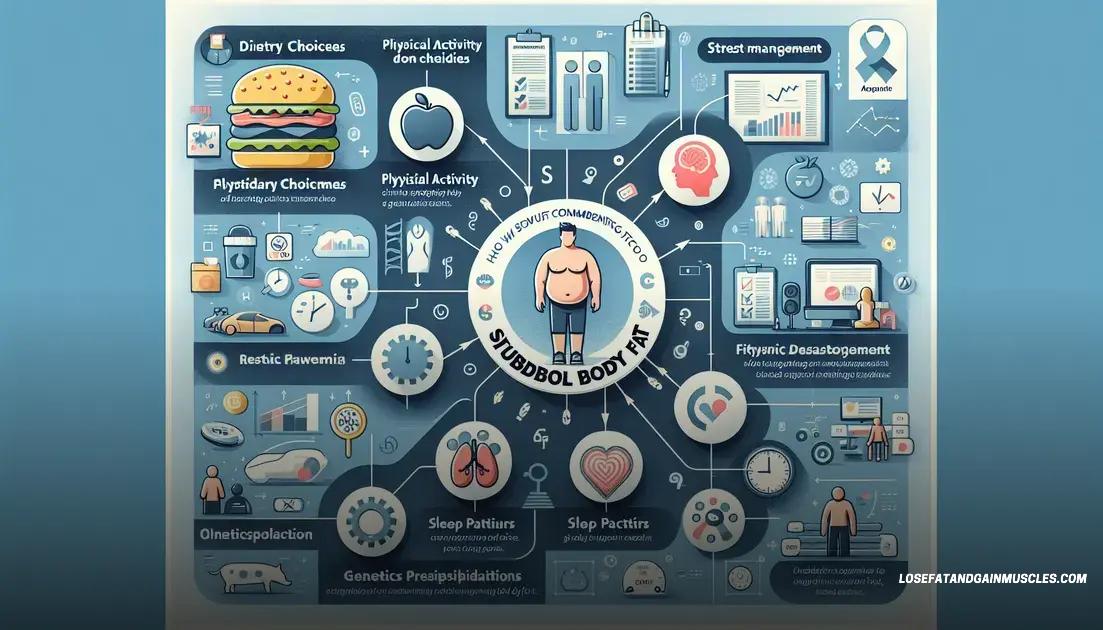Why is Lower Belly Fat So Hard to Lose? Discover the Secrets!
Losing lower belly fat can be achieved through targeted exercises, dietary changes, and understanding hormonal influences. Focus on whole foods, manage stress, and incorporate regular physical activity for the best results in reducing stubborn belly fat.
Have you ever wondered why **lower belly fat** is so hard to lose? You are not alone! Many people struggle with **stubborn fat** in this area, leading to frustration and confusion. In this article, we will uncover the factors that contribute to this common issue and discuss effective strategies to help you shed those extra pounds. Whether it’s through targeted exercises, dietary changes, or understanding the role of hormones, we’ve got the tips you need to tackle lower belly fat.
Understanding Lower Belly Fat
Understanding **lower belly fat** is essential for anyone who has struggled to lose weight in that area. Unlike other types of fat, lower belly fat can be particularly stubborn, and various factors contribute to its persistence. This type of fat is often linked to body composition and can be more prevalent in individuals with sedentary lifestyles or poor dietary habits.
What is Lower Belly Fat?
**Lower belly fat** refers to the excess weight stored in the abdominal area, specifically below the navel. This fat can be classified into two types: subcutaneous fat, which sits just under the skin, and visceral fat, which surrounds internal organs. While some level of fat is normal and necessary for health, excess lower belly fat can indicate poor health and increase the risk of diseases.
Why Is It Hard to Lose?
**Losing lower belly fat** is challenging for several reasons. First, the body tends to store fat in this area due to genetic factors, hormone levels, and lifestyle choices. Stress can also lead to the accumulation of fat in the abdominal region as the body produces more cortisol, a hormone that promotes fat storage.
Health Implications
Excess lower belly fat is not just a cosmetic concern; it can also lead to significant health issues. It has been associated with higher risks of heart disease, diabetes, and other chronic conditions. Understanding the health implications of lower belly fat emphasizes the importance of addressing it properly.
Personal Factors
Each person’s body is unique, and factors such as age, sex, and overall health can influence how fat is stored and lost. It’s important to take a personalized approach to weight loss, considering these factors to develop effective strategies.
In summary, understanding lower belly fat involves recognizing its types, why it tends to be hard to lose, and its implications on health. By learning more about lower belly fat, you can take informed steps towards managing your weight more effectively.
Factors Contributing to Stubborn Fat

Many factors can contribute to **stubborn fat**, especially in the lower belly area. Understanding these factors is crucial for effectively tackling weight loss. Here are some key contributors:
Dietary Choices
What you eat plays a significant role in fat accumulation. Consuming high-calorie, sugary, and processed foods can lead to weight gain. Foods that are low in nutrients but high in calories may increase belly fat. A balanced diet rich in fruits, vegetables, lean proteins, and whole grains is essential.
Lack of Exercise
Physical inactivity is another major factor. A sedentary lifestyle can lead to weight gain, particularly in the lower belly. Regular physical activity, including both aerobic exercises and strength training, can help decrease fat in this area.
Stress Levels
Stress can trigger weight gain, especially in the lower belly. When stressed, the body produces more cortisol, a hormone that promotes fat storage in the abdominal area. Finding ways to manage stress, such as meditation or yoga, is important.
Sleep Quality
Insufficient sleep can also affect your weight. Lack of rest can disrupt hormones related to hunger, leading to increased cravings and appetite. Aim for 7-9 hours of quality sleep each night to support better weight management.
Genetic Factors
Genetics can influence where fat is stored in the body. Some individuals naturally store more fat in the abdominal area. While you may not change your genetics, understanding this can help set realistic weight loss expectations.
By being aware of these factors contributing to stubborn fat, you can develop effective strategies to address them and work towards a leaner lower belly.
Effective Exercises to Lose Lower Belly Fat
Incorporating effective exercises can greatly aid in losing **lower belly fat**. While diet plays a crucial role, physical activity helps burn calories and strengthens muscles. Here are some effective exercises to consider:
1. Plank
The plank is a great exercise for strengthening your core. To perform a plank, follow these steps:
- Start in a push-up position with your arms straight.
- Keep your body in a straight line from head to heels.
- Hold this position for 20-30 seconds or longer if you can.
Planking engages multiple muscles, including those in the lower belly, helping you tone and reduce fat.
2. Bicycle Crunches
Bicycle crunches effectively target your abs and help burn calories. Here’s how to do them:
- Lie on your back with your hands behind your head.
- Bend your knees and lift them towards your chest.
- As you bring one knee towards your chest, extend the other leg and twist your torso, bringing your elbow toward the bent knee.
- Alternate sides in a pedaling motion for 15-20 reps.
3. Leg Raises
Leg raises are particularly beneficial for targeting lower belly fat:
- Lie flat on your back with your legs straight.
- Slowly lift your legs until they are vertical to the floor.
- Lower them back down without touching the ground. Repeat for 10-15 reps.
4. Mountain Climbers
Mountain climbers provide both strength and cardio benefits. Here’s how to do them:
- Start in a push-up position.
- Quickly bring one knee towards your chest, then switch legs in a running motion.
- Continue for 30-60 seconds.
5. High-Intensity Interval Training (HIIT)
Incorporating HIIT workouts can also effectively burn fat overall:
Choose your favorite cardio exercises, such as jogging, cycling, or jumping jacks. Alternate between intense bursts of activity and short rest periods. A typical HIIT session lasts 20-30 minutes.
By regularly incorporating these exercises into your routine, you can boost your weight loss efforts and target lower belly fat effectively.
Dietary Changes for Targeting Lower Belly Fat

Making specific **dietary changes** can help target **lower belly fat** effectively. Here are some essential modifications to consider:
1. Focus on Whole Foods
Start by incorporating more whole foods into your diet. Fresh fruits, vegetables, whole grains, and lean proteins are great choices. They provide essential nutrients that support metabolism and help with weight loss.
2. Decrease Sugar Intake
Reducing your sugar intake is crucial in losing lower belly fat. Sugary drinks, candies, and baked goods can lead to weight gain. Opt for natural sugars found in fruits instead of processed sweets.
3. Stay Hydrated
Drinking enough water throughout the day can aid in digestion and metabolism. Aim for at least 8 glasses of water daily and consider drinking a glass before meals to help control appetite.
4. Choose Healthy Fats
Incorporate healthy fats into your meals. Foods like avocados, nuts, and olive oil not only provide energy but also keep you full longer, reducing the likelihood of overeating.
5. Increase Fiber Intake
Eating more fiber is essential for a healthy diet and weight loss. Foods high in fiber, such as beans, whole grains, and vegetables, can help keep you full and satisfied.
6. Control Portion Sizes
Be mindful of portion sizes while eating. Use smaller plates to help visualize appropriate serving sizes. This practice can prevent overeating and help you stick to your weight loss goals.
7. Limit Processed Foods
Avoid processed foods as much as possible. They often contain unhealthy fats, excess sugars, and preservatives, which can contribute to weight gain. Stick to natural, unprocessed options when possible.
By incorporating these dietary changes, you can effectively target lower belly fat and support your overall health and well-being.
The Role of Hormones in Fat Loss
The role of **hormones** in fat loss is crucial, especially for targeting **lower belly fat**. Hormones are chemical messengers that regulate various functions in the body, including metabolism and fat storage.
1. Insulin
Insulin is a hormone produced by the pancreas. Its primary function is to regulate blood sugar levels. When you consume carbohydrates, insulin is released to help your cells absorb glucose for energy or storage. However, high levels of insulin can promote fat storage, particularly in the abdominal area. Reducing sugar intake can help manage insulin levels effectively.
2. Cortisol
Cortisol, known as the stress hormone, can impact weight loss. When stressed, the body releases more cortisol, which can encourage fat accumulation around the belly. Managing stress through techniques like meditation or regular exercise can help balance cortisol levels.
3. Leptin
Leptin is a hormone that helps control hunger and energy balance. It is produced by fat cells and signals the brain when you are full. Resistant leptin signaling can lead to increased hunger and decreased energy expenditure, making it harder to lose fat. Eating a balanced diet can improve leptin sensitivity.
4. Ghrelin
Often referred to as the hunger hormone, ghrelin stimulates appetite and promotes fat storage. Balanced meals that include proteins, fats, and fiber can stabilize ghrelin levels, helping you feel full longer.
5. Estrogen and Testosterone
Both estrogen and testosterone influence body fat distribution. Low testosterone levels can lead to increased fat in the belly for men, while hormonal changes during menopause can result in fat accumulation for women. Regular exercise and a healthy diet can help maintain hormonal balance.
Understanding the role of hormones in fat loss is essential for targeting lower belly fat effectively. By managing these hormones positively, you can support your weight loss efforts.
In Summary: Unlocking the Secrets to Losing Lower Belly Fat
Losing lower belly fat can be challenging, but understanding the factors at play can make it more manageable. Key aspects include recognizing the role of stubborn fat, effective exercises, and dietary changes that promote fat loss.
Additionally, acknowledging how hormones influence your body can guide you toward healthier choices. By focusing on balanced meals, regular physical activity, and stress management, you can achieve your weight loss goals.
Remember, consistency is crucial. Implement these strategies over time to see lasting results and improve overall health.
FAQ – Frequently Asked Questions About Losing Lower Belly Fat
Why is lower belly fat so hard to lose?
Lower belly fat is often stubborn due to factors like genetics, hormonal imbalances, and lifestyle choices that promote fat accumulation.
What exercises are most effective for losing lower belly fat?
Effective exercises include planks, bicycle crunches, leg raises, mountain climbers, and high-intensity interval training (HIIT).
What dietary changes can help target lower belly fat?
Focus on whole foods, reduce sugar intake, stay hydrated, choose healthy fats, increase fiber intake, control portion sizes, and limit processed foods.
How do hormones affect fat loss?
Hormones like insulin, cortisol, leptin, and ghrelin can influence appetite and fat storage, making hormonal balance crucial for effective weight loss.
Can stress impact lower belly fat?
Yes, high-stress levels can increase cortisol production, leading to greater fat accumulation in the abdominal area.
How important is consistency in my weight loss efforts?
Consistency is key in achieving and maintaining weight loss. Regular exercise and healthy eating habits over time are essential for lasting results.













